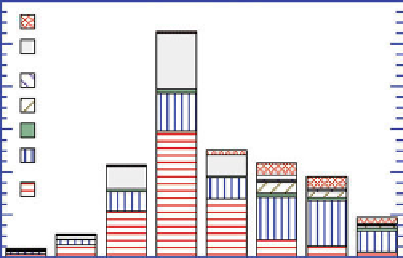Geoscience Reference
In-Depth Information
12
40
Na
+
NH
4
Na
+
NH
4
Long Beach, California
August 29, 1987
0500-0830 PST
35
Riverside, California
August 29, 1987
0500-0830 PST
10
+
+
30
Mg
2+
Ca
2+
Cl
-
NO
3
-
SO
4
2-
8
Mg
2+
Ca
2+
Cl
-
NO
3
-
SO
4
2-
25
6
20
15
4
10
2
5
0
0
0.075
0.14
0.27
0.52
1.04
2.15
4.35
8.2
0.075
0.14
0.27
0.52
1.04
2.15
4.35
8.2
Stage 50-percent cutoff diameter (µm)
Stage 50-percent cutoff diameter (µm)
(a)
(b)
Figure 5.15.
Measured concentrations of inorganic aerosol particle components versus particle diameter at
(a) Long Beach and (b) Riverside, California, on the morning of August 29, 1987. Data were obtained by John
et al. (1990) with an eight-stage Berner impactor.
Ammonia is frequently present in particles contain-
ing sulfate, and such particles are usually present in
the accumulation mode
.When nitrate ion concentra-
tions in the accumulation mode are high, the nitrate is
also balanced by ammonium ions. Figure 5.15 illus-
trates this point by showing measured aerosol particle
compositions versus size at Long Beach and Riverside,
California. Long Beach is a coastal site, and Riverside
is located 60 km inland in the Los Angeles Basin. At
Long Beach, sulfate dominated, but nitrate was present
in the accumulation mode. At Riverside, nitrate domi-
nated, but some sulfate was present in the accumulation
mode. Ammonium ions balanced charge with nitrate
and sulfate ions in the accumulation mode at both Long
Beach and Riverside.
The most abundant sulfate-containing electrolyte in
aerosol particles on a global scale may be
gypsum
[CaSO
4
-2H
2
O(s)] (Jacobson, 2001a), which can form
at any relative humidity below 98 percent. Gypsum
forms when calcium and sulfate react in sea spray drops
or soil dust particles; thus, it is present primarily in
the coarse mode.
Ammonium sulfate
[(NH
4
)
2
SO
4
(s)],
which forms in accumulation mode particles, may be
less abundant than is gypsum, but it is more impor-
tant than gypsum in terms of its effects on visibility
because the accumulation mode affects radiative fields
more than does the coarse mode.
In urban regions, where nitrate production and
ammonia gas emissions are high, concentrations of
solid
ammonium nitrate
[NH
4
NO
3
(s)] often build up.
In Figure 5.15, for example, some of the ammonium
and nitrate in accumulation mode particles probably
formed ammonium nitrate crystals. Ammonium nitrate,
in either liquid or solid form, is considered to be one
of the major causes of visibility reduction in Los Ange-
les smog. The major sources of the nitrate ion is nitric
acid formed from fossil fuel emissions of NO
x
(g). The
major source of the ammonium ion is ammonia emitted
by cattle, such as in the feedlots of Chino, just east of
Los Angeles.
5.3.2.1.7. Solid Precipitation.
When their concentra-
tions in aerosol particle solution are high, ions may
precipitate to form
solid electrolytes
.Indeed, many
soils of the world have formed from the deposition of
solid minerals originating from aerosol particle solu-
tions.
Precipitation
is the formation of an insoluble
solid compound due to the buildup in concentration of
dissolved ions in a solution. Solids can be suspended
throughout a solution but are not part of the solution. If
the water content of a solution suddenly increases, solid
electrolytes often dissociate back to ions. Solid elec-
trolytes generally do not form in cloud drops because
these drops are too dilute. For a similar reason, solid
formation is often inhibited in aerosol particles when
the relative humidity is high.
5.3.3. Removal Processes
Aerosol particles are removed from the air by rainout,
washout, sedimentation, and dry deposition.
Rainout
occurs when an aerosol particle CCN activates to form


Search WWH ::

Custom Search